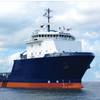For Commercial Vessels, VIDA Will Usher in New Era of Uniformity
With everything going on around the maritime industry these days — from a Presidential Executive Order to Make U.S. Maritime Great Again, to bipartisan legislation in Congress to boost our shipyards and merchant marine, to the import tariff rollercoaster ride we’re all on — it’s easy to forget some other important U.S. maritime policy initiatives whose benefits are just over the horizon. One such initiative we mustn’t lose sight of is the effort by the U.S. Coast Guard and the U.S. Environmental Protection Agency (EPA) to implement the Vessel Incidental Discharge Act of 2018 (VIDA).
Enacted and signed into law in December, 2018, VIDA is designed to supersede and replace the current patchwork quilt of competing, sometimes conflicting, and often confusing EPA, Coast Guard, and individual U.S. state requirements for the treatment and management of ballast water and numerous other types of discharges that are routine in a vessel’s everyday operations. In place of the current jumble of requirements, EPA and Coast Guard, acting pursuant to VIDA, are to establish nationally uniform, environmentally sound standards for the regulation of ballast water and other incidental discharges by commercial vessels 79 feet and greater in overall length. Under VIDA, the EPA is tasked with implementing national performance standards for treatment equipment and management practices for incidental discharges, while the Coast Guard is charged with promulgating implementation, compliance, and enforcement regulations for those standards.
Last October, the EPA issued its final rule for the national performance standards. The effective date of the rule was November 8, 2024, but the performance standards do not actually have force and effect until the Coast Guard issues its regulations. Under VIDA the Coast Guard has until November 8, 2026, to promulgate its implementation, compliance, and enforcement regulations. At the time of this writing, Coast Guard has yet to publish a proposed rule, but when they do it will be important for vessel owner/operators and other maritime interests to review the proposal carefully and provide the Service with thorough, constructive comments.
It also is of critical importance for U.S. maritime interests to remind the Department of Homeland Security and the Trump Administration more broadly that VIDA was and is deregulatory in nature. It is a bipartisan, bicameral effort to bring order to, clarify, and simplify how commercial vessels manage the multitude of discharges that are a normal part of their operations.
To truly understand the importance of VIDA, it’s worth summarizing how the current regulatory mess came to be what it is today. In 1973, when the EPA first implemented the National Pollutant Discharge Elimination System (NPDES) under section 402 of the Clean Water Act, it intentionally excluded vessels from the NPDES permitting requirement for pollutant discharges by point sources. At the time, the EPA justified its action with the observation that “this type of discharge generally causes little pollution and exclusion of vessel wastes from the permit requirements will reduce administrative costs drastically.”—in essence, the juice wasn’t worth the squeeze. In 2005, this exclusion from NPDES permitting was overturned when, as a result of environmental citizen suit litigation, the 9th Circuit Court of Appeals upheld a lower court ruling that excluding vessels as a point source under NPDES was an action by EPA that was outside its statutory authority under the Clean Water Act.
During the 32 years that the NPDES vessel exclusion was in place, Congress responded to growing concerns about aquatic invasive species by enacting the Nonindigenous Aquatic Nuisance Prevention and Control Act of 1990 (NANPCA), and further amended it in 1996 with enactment of the National Invasive Species Act (NISA). NANPCA/NISA requires the Coast Guard, in coordination with the EPA and other agencies, to create and oversee a program for the management of ballast water to prevent nonindigenous species from being introduced into U.S. waters, with ballast water from vessels being the prime vector for invasives.
Also prior to the federal courts’ overturning of the EPA’s exclusion of vessels from NPDES, in 2004 the Coast Guard and the Department of State headed a U.S. Delegation to the International Maritime Organization (IMO) where the International Convention for the Control and Management of Ships’ Ballast Water and Sediments (Convention) was adopted. The Convention includes a number of important provisions relating to research and development of treatment technology and the roles of flag states and port states in adoption and use of that technology, but most importantly it includes a ballast water treatment standard based on the number of living organisms contained in discharged ballast water that is the most stringent standard scientifically proven to be achievable and detectable today (“Regulation D-2”).
Today, as a result of these independent developments, both the Coast Guard and EPA are regulating ballast water under distinct, uncoordinated, and sometimes clashing sets of requirements—the Coast Guard under NANPCA/NISA and the EPA under the Clean Water Act and NPDES. While both the Coast Guard and the EPA have adopted the IMO Regulation D-2 standard as their treatment standard for ballast water, there has been considerable confusion between them and among vessel owner/operators over how to administer, and properly comply with, the agencies’ varying requirements.
Adding to the confusion for vessel owner/operators is the fact that, under the Clean Water Act, NPDES, and the EPA’s Vessel General Permit (VGP) that it has used to manage vessel effluent limitations, the EPA’s management requirements are only a federal “floor”—meaning individual U.S. states have the ability to set additional effluent limitations and management requirements in their waters, on top of federal requirements. Several states have done so since the VGP went into effect with little or no coordination with one another, resulting in varying requirements depending on the state waters in which a vessel finds itself. For those readers familiar with the historic emphasis on uniformity in the field of maritime law and policy, this is a far cry from it.
Once fully implemented by EPA and Coast Guard, the current hot mess of federal and state commercial vessel discharge management requirements and limitations will be superseded by a single, uniform set of national requirements. Some of you know that I personally invested a decade of my professional life as a U.S. Senate committee counsel getting VIDA to the President’s desk, and others too numerous to name here invested even more years than I did. Uniform treatment and management rules for commercial vessel discharges are a no-brainer—from facilitating vessel owner/operator compliance under simplified, uniform requirements to the ease of Coast Guard enforcement that comes with such requirements.
As DHS and the Trump Administration contemplate which rulemakings they will and will not prioritize, I urge every vessel owner/operator and every mariner coping with the patchwork quilt of overly complicated and confusing regulations to communicate to them, through whatever means available, the importance of Coast Guard’s VIDA implementing rule. Uniformity: we are almost there!















